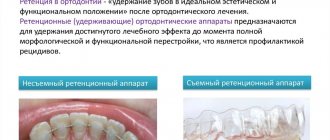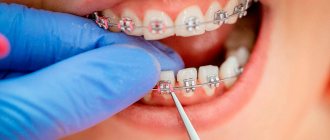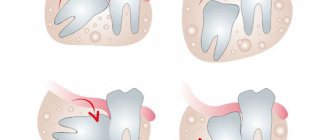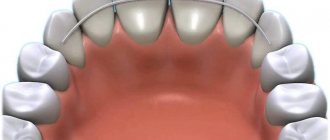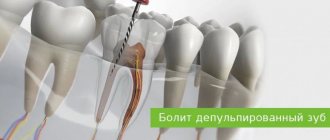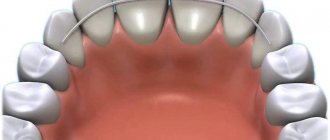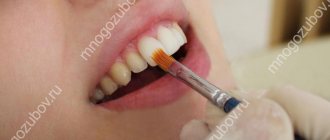28.11.2019
At the moment when the doctor informed the patient that the treatment process is over and that the braces system can be removed, teeth whitening after removing the braces becomes the most significant and important aspect for the client of the dental clinic. This is explained simply, because having received the desired result in the form of an even and beautiful row of teeth, the patient often faces unpleasant side effects in the form of stains on the tooth enamel. To get rid of such troubles, it is necessary to perform whitening so that no plaque or tartar remains on the teeth.
Is it possible to whiten teeth after braces?
It is not difficult to understand a patient who, after removing braces, suddenly discovers spots of different colors on his teeth; his desire to whiten looks quite natural. Of course, you can whiten your teeth after removing braces, but you will have to wait a little, about a month, before starting this procedure. By the way, there are also situations when a specialist recommends increasing the waiting period due to the individual characteristics of the patient’s oral cavity and the poor condition of his teeth. Whitening is based on a chemical reaction, as a result of which the released active oxygen penetrates the upper layers of the teeth and brightens them. Such an intervention is stressful, hence some pain experienced by the patient after its completion.
In any case, there is no need to rush, even if the appearance of the jaw is so smooth and beautiful because of its color. There are two important aspects that support this statement:
- during the waiting period, the enamel will be restored and will no longer be depleted and weak;
- the natural color of some areas can be restored without external aggressive intervention.
How to do whitening?
The teeth whitening procedure is one of the most effective and highly popular among dental patients. Its rather high cost is not the most pleasant moment, but the result obtained justifies all financial investments and costs.
When contacting a dentist with a similar problem, you can count on the following methods to solve the problem:
- hygienic cleaning with the help of which removes plaque and tartar, and also restores the natural color of the enamel;
- laser cleaning, which requires perfect cleanliness but gives excellent results;
- the use of special whitening strips that remove the yellow color of teeth and return them to their natural color.
Advantages and disadvantages of whitening
The key advantage of the whitening procedure is manifested in a person’s beautiful snow-white smile. In addition, yellow teeth are not only not very beautiful, but also not very stable, and this is not only a problem with the appearance of the teeth. Whitening makes it possible to get rid of plaque and tartar, prevents the growth of bacteria in the oral cavity, and accordingly the risk of developing caries is reduced.
However, whitening also has disadvantages, in particular the likelihood of certain complications, which are not difficult to avoid; it is necessary to visit the dentist in a timely manner to diagnose the condition of the enamel.
To correct bite pathologies in orthodontics, braces are used - non-removable structures installed on a row of teeth.
The entire mechanism consists of small clasps, arches, ligatures and many other additional parts, which make it difficult to carry out high-quality cleaning of the oral cavity. Due to lack of or improper hygiene procedures, a favorable environment for the growth of bacteria is formed in the oral cavity. In addition to bad breath, this threatens the development of caries, gingivitis, periodontitis and the accumulation of tartar.
What do you need to purchase for high-quality cleaning of braces and teeth?
Oral hygiene with braces will require the purchase of many additional products. Using a regular toothbrush will not help clean hard-to-reach places and small parts of the structure itself.
You will also need:
- Orthodontic brush for braces. Its difference from the brushes we are accustomed to is the existence of a V-shaped cutout on them, which is located in the middle. This cutout allows for more thorough cleaning around the teeth, braces and archwire.
- Orthodontic brushes. With their help, food debris is removed from the spaces between structural parts and teeth. Thanks to a large selection of shapes and sizes, you can choose according to the individual characteristics of the patient.
- Dental floss (floss or super floss) – designed for cleaning teeth and braces. For braces, it is better to use superfloss. This thread has a variable thickness along its length, which allows you to clean the structure better.
- Special dental pastes and liquids. Throughout treatment, it is recommended to give preference to fluoride-containing drugs.
If possible, you can purchase an irrigator - an orthodontic device that supplies a special liquid or water under pressure. The outgoing thin stream cleans gaps and hard-to-reach areas of the structure. An irrigator is quite an expensive device, but it will do the most to ensure high-quality cleaning of the bracket system.
Mandatory rules for caring for braces
The first rule before installing braces is to carry out a complete sanitation of the oral cavity. Tartar is removed, caries is cured, teeth are whitened. Treatment of a malocclusion can last about two years, and if mouth sanitation is ignored, the presence of caries or tartar during this time can lead to tooth loss. If the attending physician missed this point in treating the bite, you should doubt his professionalism.
Hygiene with braces includes additional rules, the observance of which is also important:
- To properly clean your teeth and braces, you will need to increase the time of hygiene procedures. The first couple of weeks you will have to allocate 30 minutes for each cleaning. Afterwards, when skills are acquired, the entire procedure can take 10 minutes.
- The cleaning itself is repeated at least three times a day. If you eat more often, then you should stick to the rule - eat and cleanse within 15 minutes. After this time, the stuck food will begin to decompose, which will lead to bad breath. And the aesthetic appearance will be spoiled if the remains of breakfast or lunch appear in the bracket system.
- During procedures, utmost attention is paid to the interdental spaces.
- They will help strengthen tooth enamel and saturate it with mineral pastes that contain fluoride and calcium.
- It is mandatory to always have dental floss, brush or irrigator with you. An unforeseen situation may occur when you have to have lunch in a cafe or restaurant, and there are no means to clean your mouth.
In addition to the basic rules, you should strictly follow the sequence of the procedure itself on how to clean braces. Don’t be afraid if at first you can’t do everything well. Experience comes with time, and if you stick to the right routine, cleaning your braces will become as common a procedure as simply brushing your teeth.
How to clean braces: description of the procedure
The procedure for properly cleaning teeth with installed braces consists of the following steps:
- If the design contains additional elements in the form of elastic bands and rods, they are carefully removed. After rinsing your mouth with water, begin cleaning your teeth. To start, use a regular brush. Using habitual movements, it helps remove impurities.
- Next, using an orthodontic brush, the brackets, braces and arch are cleaned. Horizontal movements are carried out along the arc. Particular attention is paid to intervals. Each tooth should take at least 10 seconds. A well-chosen brush can eliminate 80% of bacteria.
- The gaps between braces and teeth can be cleaned well using a brush. Reciprocating movements help to better remove contaminants. You also need to use a brush to carefully walk along the root zone and gingival sulcus.
- Having a waterpik will help soften and push out any remaining food particles.
- The final stage involves the use of superfloss. A new piece of floss is used for each individual space between the teeth. Afterwards, the oral cavity is rinsed with a special liquid and then with clean water.
To avoid damage to the bracket system, the cleaning procedure is performed with light movements without unnecessary pressure.
Professional teeth cleaning with braces
Even if the patient knows how to properly clean braces and follows all the rules, it is still not possible to carry out the cleaning procedure perfectly. Plaque often appears on the teeth, which cannot be cleaned with ordinary orthodontic appliances. The attending orthodontist will initially advise you to undergo professional teeth cleaning with braces at a dental clinic every 2 months.
Sign up for professional hygiene at the Smile Land clinic by phone +7 (473) 211-37-36.
Why is there a need for teeth whitening?
A very common unpleasant surprise for patients who have undergone treatment with braces, which is not possible to predict in advance, is a change in color in areas of the enamel not covered by the system. The most likely cause of such unattractive stains is eating foods with dyes, smoking and insufficient attention to oral hygiene. The bracket system serves as reliable protection against darkening, but after its removal, a real color imbalance is observed, which has to be restored with the help of bleaching.
Braces turned yellow: reasons
As a rule, not all braces change color. Plastic, ceramic, and sapphire bracket systems are susceptible to this. This happens under the influence of food colorings, for example, if you drink a lot of coffee or tea, smoke or often eat dark berries. This is why braces gradually lose their original whiteness.
However, it is worth remembering that the material from which the braces are made cannot turn yellow: the ligatures with which the plates are attached to the arch turn yellow. The reason for the deterioration in the appearance of braces may also be that plaque accumulates on the braces, which becomes more noticeable over time.
Three ways to solve the problem
The problem of darkened enamel can cause serious inconvenience not only after removing the structure, but also during its wearing. In this case, the option of removing the system and performing teeth whitening is acceptable, but this is only permissible in a frankly advanced case, as well as if the patient has very decent funds, because you will have to pay for the additional work of a specialist. In all other situations, there are two other ways: teeth whitening after removing braces professionally or at home.
Features of teeth whitening after orthodontic treatment
There are many different methods that can successfully answer the question of how to whiten teeth, but not all of them are suitable for a patient who has just finished wearing braces. That is why it is so important to carry out this procedure only with the help of a specialist, using exclusively professional techniques. Each person has his own individual characteristics of the mucous membrane and enamel; accordingly, the selection of the necessary whitening gel, its composition and the concentration of the necessary substances in it must be carried out by a specialist. If this aspect is ignored, then the lack of the expected result will be less of a nuisance, but it will be much worse if serious damage is caused to the enamel.
Note: It should be understood that for teeth, especially if they have been damaged or weakened after installing and removing the braces, whitening is a serious stress.
Therefore, teeth whitening after removing braces should be performed no earlier than a month after their removal, so that the enamel has time to strengthen and the teeth to adapt to the new shape. True, whitening is not required in all situations; it happens that it will be quite enough to remove plaque without resorting to more radical solutions.
Summarizing all of the above, we can formulate three key rules for teeth whitening after the braces are removed:
- Use only professional techniques.
- You can start whitening after removing the system after a month.
- It does not always make sense to perform whitening; after consultation with a doctor, you can limit yourself to professional teeth cleaning.
Nutritional Features
Do not be alarmed - a person will not be required to strictly adhere to a diet, but dietary adjustments are still necessary. Wearing braces imposes some restrictions on food intake, and for their safety and dental health, it is better to follow all the doctor’s recommendations. It is advisable to avoid consuming the following foods:
- Sticky and viscous confectionery products: chewing gum, chewing candies, toffees and other products that stick strongly to the teeth. Sticky foods can lead to tooth decay and other dental diseases.
- Solid foods. These include sweets, crackers, nuts, as well as hard fruits and vegetables: apples, carrots - all those that need to be bitten. Hard ones can cause serious damage to tooth enamel, as well as displace the structure and lead to its improper functioning. In addition, detachment of the structure may occur, which will require dental intervention.
- Coloring food that contains a large amount of dyes of natural or artificial origin.
- Hot or cold foods. Sudden temperature changes have a particularly negative effect: for example, drinking cold ice cream after hot coffee. It is recommended to refrain from eating too hot or cold food, limiting yourself to eating warm dishes.
Types of teeth whitening after removing braces
Existing teeth whitening techniques can rightfully be called unique and specific, but they all have common features:
- The whitening procedure should be preceded by a diagnosis of the enamel and its condition, because if it is severely weakened, then chemical intervention will cause even more harm to it, accordingly, it will first need to be strengthened;
- in all cases, a key role is played by a special gel made taking into account the individual characteristics of the patient;
- the basis of the bleaching agent is made up of chemical elements such as hydrogen and carbonate peroxide, the concentration of which is approximately 20%;
- the whitening effect is achieved due to the release of active oxygen that penetrates the enamel as a result of a chemical reaction;
- Upon completion of whitening, it is necessary to perform procedures to strengthen the top layer of teeth.
The main difference between different bleaching methods will be in the methods of accelerating the reaction, which in turn directly affects the final result of the entire process.
Home whitening after braces is an unjustified risk
Using popular non-professional home whitening techniques, you can cause significant damage to your teeth. Chemical teeth whitening agents purchased at the pharmacy or recommended on online forums can destroy not only the thin layer of damaged enamel, but also the porous tooth tissue located underneath it. As a result, a patient who has spent a considerable amount on treatment with sapphire or self-ligating braces and is trying to save money on a whitening procedure may simply lose individual teeth.
Preparing for whitening in the clinic - teeth cleaning
When the orthodontist has completed the procedure for removing braces, he then proceeds to the procedure of professional teeth cleaning, which involves the following operations:
- Elimination of glue residues from enamel. It is a well-known fact that the clasps of the braces structure are attached to the teeth using an adhesive base. Some of this substance remains on the enamel after removing the system, therefore, it must be completely removed.
- The procedure for removing plaque and tartar, without this it is not possible to perform whitening.
Let us assume the option of using special trainers, which in this case will be used with a bleaching composition.
Cleaning before braces: why is it needed?
Correction of the bite always begins with sanitation of the oral cavity. In addition to treating diseases of the teeth and gums, it includes mandatory professional cleaning before installing braces. The doctor will remove hard deposits with ultrasound, and soft deposits with a thin and powerful jet of cleaning powder solution (AirFlow technology). After this, the teeth will need to be polished with a special paste and coated with a fluoride-containing preparation to strengthen the enamel. Such a hygienic procedure should be carried out 3 - 5 days before installation, but no later than 24 hours.
What happens if you don’t brush your teeth before braces? Bacterial plaque will get under the elements of the system, in particular under the clasps that are glued to the enamel. Considering that orthodontic appliances are worn for a year at best, and two years on average, microorganisms will have enough time to multiply and lead to the formation of caries. It is impossible to properly cure it with braces on the teeth. There is a risk of early removal of the device, and this will spoil the final result, and the patient will waste money, time and moral strength. This is why brushing your teeth before getting braces is mandatory.
Be patient
Many patients, who are ready to amaze the world with their truly snow-white and dazzling smile after removing braces, almost panic when they see darkened spots on their teeth and immediately intend to carry out the whitening procedure. You should not rush; you will need to wait at least a month, or even more, for the tooth enamel to return to normal and recover after wearing braces. Moreover, it happens that after some time it returns to its usual appearance on its own and bleaching becomes an absolutely unnecessary operation. In addition, you should always remember that its action is based on a chemical reaction, which is aggressive in nature; you should weigh everything well and think it over before exposing your teeth to such effects.
Rules for caring for braces after installation
And finally, the orthodontic structure is put on. There are many months, or even years of treatment ahead, during which you will need to devote a lot of time to oral hygiene. Cleaning braces is not an easy task. An orthodontic apparatus is a complex system with many elements: clasps, arches, ligatures, rings, springs, hooks for elastic rods... And on each of them food particles can remain and plaque can accumulate.
Recommendations for caring for the braces system
- You need to brush your teeth at least three times a day, and ideally after every meal, even a small snack.
- It is necessary to brush not only your teeth, but also between them. Dental floss will help clean the interdental space.
- The hygiene of braces must be the most thorough: all elements of the system will have to be processed on each side, avoiding the accumulation of plaque.
- You will have to purchase special brushes for cleaning braces, as well as additional devices such as an irrigator. We will talk about this in more detail below.
- To clean the braces system and teeth, a fluoride-containing paste is used, as well as a fluoride-containing rinse, which completes the oral hygiene procedure with braces.
- It’s best to always carry a toothbrush and floss with you in case you need to eat out.
- For those who wear braces, care and nutrition go hand in hand. During treatment, you will have to give up a number of foods—hard, sticky, fibrous, and anything else that could damage your braces or get stuck in them. You should also significantly limit sweets.
Hygiene of the brace system is a key task for the entire period of wearing an orthodontic device. If it is neglected, whitish spots may appear on the enamel of the teeth - traces of demineralization and the accumulation of bacterial plaque. They look unaesthetic and spoil the impression of the results of long-term treatment.
Gentle method
This problem may have a simpler solution that does not require such radical measures, namely the most common hygienic action based on the use of AirFlow water-abrasive cleaning. Its use eliminates the negative impact on enamel, since it does not involve the use of aggressive chemicals. Many experts recommend performing this cleaning method first after removing the system, and if this option does not give the expected result, then after some time the issue of bleaching can be put on the agenda.
How to whiten teeth at home?
This may seem strange, but at home it is quite possible to get very good whitening results using the following techniques:
- the use of whitening gels, which give excellent and, very importantly, long-lasting results;
- the initial stage of tartar and plaque can be easily removed by regular brushing of the teeth and mouth, which should also include the use of dental floss and rinses;
- using herbal infusions, for example, sage leaves, which will have a beneficial effect on the condition of the gums.
Cleaning and whitening at home should be carried out with a high degree of accuracy and caution, because teeth have become more sensitive, and any aggressive impact can have the opposite effect on them than expected.
What hygiene products are there for braces?
Modern manufacturers produce a huge number of various products and devices that provide complete oral hygiene and high-quality care for braces. The most popular and effective among them are:
- V-shaped brushes. They differ in the shape and location of the villi, ensuring penetration even under the braces.
- Multi-tuft brushes. Such designs are designed to eliminate plaque in the interdental space. The hardness of the pile is of great importance.
- Cleaners. This is a pen-holder with a metal rod, into which nylon pile is woven. The working element can be conical or cylindrical, and the user decides which shape is more convenient for him.
- Irrigators. This device removes plaque using a jet of water. Water is supplied from a special container built into the handle of the device.
- Flosses. These are special dental flosses that allow you to clean not only the space between the teeth, but also the elements of the system.
Lemon
The ascorbic acid contained in lemon is beneficial not only for human gums, but also for the entire body. As for whitening with lemon, there are many options for this procedure, the simplest of which involves using one slice of a simple lemon to treat the enamel. Let’s also say a method based on adding a few drops of lemon juice to the toothpaste, which, by the way, will also help with bleeding gums.
Such products should be used carefully, no more than once a week; those who have increased tooth sensitivity should be especially careful.
Category Hygiene Published by Mister stomatolog
Pastas for every day
These are pastes that clean well, strengthen and have a moderate antibacterial effect. They do not contain chlorhexidine or similar components and can be used every day.
Toothpaste ROCS PRO Brackets & Ortho
PresiDENT PROFI ORTHO BRACES toothpaste for braces
Philips Sonicare BreathRX toothpaste
Biorepair PLUS Total Protection toothpaste
